Dystocia in Beef Cattle
Agriculture and Natural Resources
MT202501AG
New May 2025
By Megan Van Emon, MSU Extension Beef Cattle Specialist; Hannah DelCurto-Wyffels, MSU Associate Teaching Professor in Animal and Range Sciences; Rebekah Clark, MSU Undergraduate Student in Animal Science
DYSTOCIA IN CATTLE IS DEFINED AS A DIFFICULT OR ABNORMAL BIRTH. It can occur due to a calf not being in a normal or optimal position for delivery or when the cow has abnormalities that can make delivery difficult (Figure 1). Dystocia is a leading cause of calf loss and a serious economic issue in the beef cattle industry, with some studies reporting that at least one-third of calf losses on a given operation are associated with dystocia. It can have direct negative effects on both the calf and the cow. However, timely and appropriate intervention during a dystocia birth can result in a positive outcome for both the cow and calf. Regular observation, an understanding of the normal stages of labor, and adequate equipment are necessary when assisting during a difficult birth. Proper dystocia intervention reduces calf mortality and the need for intensive postnatal care and reduces injury risk to the cow.
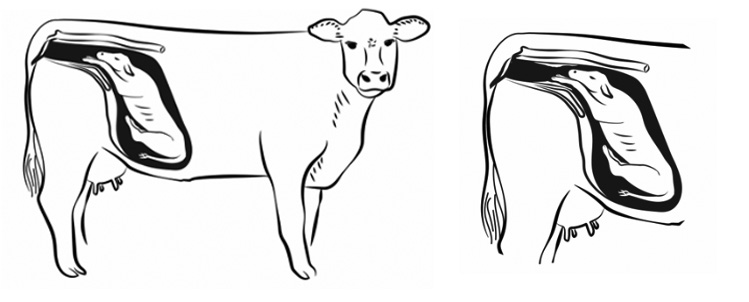
Figure 1. Examples of common abnormal presentations in comparison to a normal presentation. (Image: Beef Cattle Research Council).
Consequences of dystocia
Dystocia events can be associated with an increased risk of stillbirths, morbidity, and calf death post-calving. During a difficult birth, calves can be deprived of oxygen if the umbilical cord is constricted, rendering the calf oxygen-deprived. This is referred to as hypoxemia or low arterial blood oxygen. Hypoxemia can cause calves to be weak at birth and therefore impact their ability to stand, nurse, and properly function. In general, most calves born from dystocia events take longer to stand and nurse, which means they often absorb lower amounts of immunoglobulins and other nutrients from their mother’s colostrum. Because of this decreased transfer of immunoglobulins, dystocia calves are more likely to have health issues such as calf scours, pneumonia, or the infection known as navel ill.
Additionally, postpartum cows that suffer from dystocia are at increased risk of metritis or uterine infection. Metritis can lead to prolonged uterine involution, the process by which the uterus returns to normal size and function. This can cause a longer return to estrus. Severe dystocia can also cause physical trauma to the cow during calving. In many cases, the trauma is limited to soft tissue tears, but it can be as extreme as nerve paralysis. These severe cases also prolong uterine involution, return to cyclicity, and ultimately result in reduced fertility and her longevity.
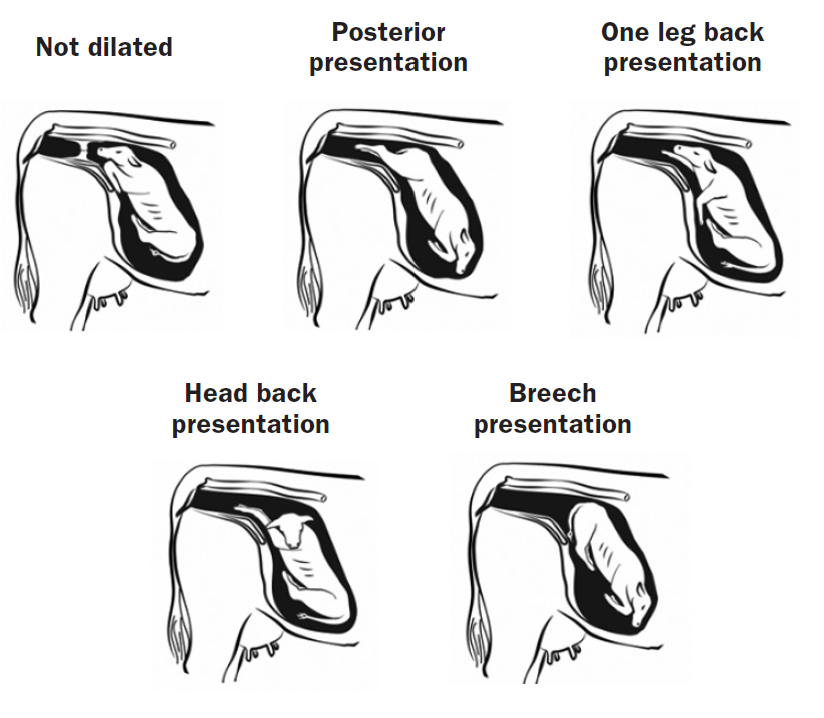
Generally, first-calf heifers have a higher incidence of dystocia than mature cows. First-calf heifers are still growing, and their pelvic canal kmay not have reached its total mature size by the time they give birth to their first calf. Heifers have issues with dystocia because of a maternal/fetal disproportion, meaning the calf is too large for the birth canal. In comparison, dystocia in mature cows is more commonly associated with abnormal presentation or a deformed calf. However, even in the absence of maternal/fetal disproportion, the birthing process is typically longer and can be more difficult for first-calf heifers.
Factors associated with dystocia
Many management and genetic factors can affect the incidence of dystocia, but the most common cause of dystocia is maternal/fetal disproportion. Other factors associated with dystocia include calf birth weight, calf sex, gestation length, pelvic diameter and cow size, nutrition and body score, and movement.
CALF BIRTH WEIGHT
The risk of dystocia increases as the calf’s birth weight increases. Producers should consider the factors that influence birth weight to help prevent dystocia. These include the genetic traits of the sire and dam and can be assessed with the use of expected progeny differences (EPDs). Expected progeny differences allow for comparison between animals for their genetic potential for a given trait. Regarding calving, producers should pay special attention to the EPDs for birth weight and calving ease.
CALF SEX
The sex of the calf can also play a role in dystocia events. Bull calves often outweigh heifer calves at birth, which is partly due to inherent biological differences between males and females. Because of heavier birth weights, bull calves tend to have a higher calving assistance rate. Some studies have shown that dystocia rates in mature cows carrying bull calves are twice that of mature cows carrying heifer calves.
GESTATION LENGTH
Calving difficulty can be indirectly affected by the gestation length of the calf. As the gestation length increases, the birth weight of the calf increases. Cows can be selected for shorter gestation lengths and lighter birth weights to help mitigate the chances of dystocia occurring. It is important to consider that selecting for shorter gestation lengths in cows can have negative effects, including potentially weaker and less vigorous calves. Therefore, selecting low-birth-weight bulls in relation to the cow base is a more effective approach to help reduce the incidence of dystocia.
PELVIC DIAMETER AND COW SIZE
Cow pelvic diameter determines the maximum calf size she can accommodate before she begins to experience calving difficulty. Pelvic dimensions are correlated with cow size. When producers select for larger pelvic dimensions, they also indirectly select for larger heifers, which then tend to produce larger calves. This is highlighted by larger cattle breeds having larger pelvic areas and producing calves with heavier birth weights, while smaller breeds have smaller pelvic areas and have calves with lighter birth weights. This also suggests that pelvic diameter has not been a reliable selection method to help reduce the incidence of dystocia.
NUTRITION AND BODY CONDITION SCORE
Nutrition can have an impact on reproduction, calving and the incidence of dystocia. In general, inadequate protein intake during gestation can result in decreased calf vigor, delayed uterine involution, increased interval to estrus, and lower conception rates following calving. These problems can be further increased when energy is deficient as well. A properly balanced diet for cows during pregnancy is crucial.
Nutrition directly affects the body condition scores of cattle, which is another factor that contributes to calving difficulty. The ideal body condition scores for cattle during calving are between 5 and 6 in mature cows and around 6 for first-calf heifers. Producers should pay close attention to heifers and cows that are very thin (BCS 1-3) or carry extreme amounts of fat (BCS 8-9). Underfeeding cows can result in calving difficulty due to a lack of strength and endurance during delivery. This can occur because of a lack of dietary energy resources and/or body reserves. These cows may also tend to have weak, non-vigorous calves. Overfeeding cows can lead to an increase in calf size, which can then cause dystocia. Therefore, it is important that cows are not over- or under-fed during pregnancy. Instead, they should be provided adequate feed to meet their nutritional requirements. Similarly, be sure to design rations to meet the requirements of cows based on their location — pasture or a drylot pen — during gestation.
MOVEMENT
Producers should avoid moving cows close to calving. Moving cows in late gestation can cause stress, which can lead to the cow aborting. Minimizing stress close to calving will help decrease the risk of dystocia.
Assisting during a dystocia birth
Despite a producer’s best efforts to avoid dystocia, some cases can still occur. Early and appropriate intervention can help to minimize the effects of dystocia on calves. Normal delivery should occur within two hours after the water bag appears. For first-time heifers, this can be up to three hours. Producers should be well-informed to intervene appropriately during difficult births and recognize when to call their local veterinarian. It is important to determine the viability of the calf before trying to correct any problems. If the calf is dead, contact the local veterinarian to see what steps to take next to protect the health of the cow.
When trying to correct an abnormal presentation, it is important to work carefully and quickly. During prolonged dystocia births, most of the amniotic fluid has already been expelled, and the uterus will have contracted around the fetus. This makes fetal expulsion and manipulation difficult, so the producer must use sufficient lubrication. Insufficient lubrication can lead to damage during the manipulation process. In the instance of early dystocia recognition, there may still be room to manipulate the uterus, however, it is best practice to always use lubricant during transvaginal manipulation.
If the producer believes that they can successfully correct an abnormal presentation, the first step to determine whether the calf is likely to be successfully pulled. A good rule of thumb to remember is that if the calf’s fetlocks can be pulled about 4 inches outside of the vulva and the calf’s head is completely in the pelvic canal, the calf can usually be pulled. Veterinary assistance should be sought immediately if the producer does not know how to correct the problem, cannot correct the problem, or it is taking longer than 30 minutes to correct the problem.
Before assisting the cow, be sure to safely restrain her to help ensure the safety of both the cow and the person assisting. Properly restraining the cow also facilitates proper examination and intervention and allows for controlled traction and repositioning of the calf.
Common abnormal presentations and potential correction methods
HEAD RETAINED
A common cause of dystocia is when the calf’s head is retained, in which both forelegs present normally, but the calf’s head is turned back along its chest. This can initially be mistaken for a backward-presenting calf (Figure 2). If there is enough room in the uterus, this abnormal position can be corrected, and the calf’s head can be brought back around to face the birth canal.
Before working to correct this presentation, try to estimate if the calf can be delivered vaginally. During labor, a calf’s head may turn to the side if there is not enough room in the pelvis for the head and both forelegs. Looking at the size of the calf’s feet can help estimate its size. The larger the feet, the larger the calf will tend to be. If it is determined that correction of an abnormal presentation will still not allow for a vaginal delivery, either due to large calf size or inadequate cow pelvic size, then a C-section may be necessary.
If it seems as though the calf will fit through the cow’s pelvis and the abnormal presentation can be corrected, then the calf can be safely pulled. The calf may have to be pushed slightly back into the uterus in order to reach the calf’s head. Ideally, if you can grasp the underside of the calf’s jaw with your hand, you can raise the head slightly while carefully and gently turning it so the head presents in the birth canal (Figure 3). Do not pull on the jaw because it can be easily broken. In some instances, it may be easier to grasp the top of the calf’s head or muzzle.
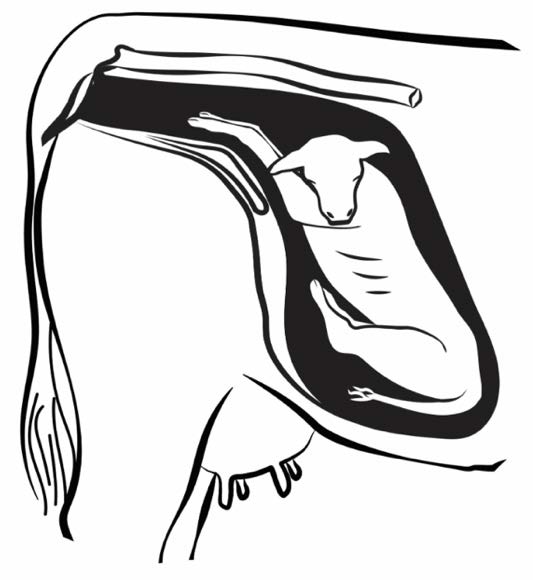
Figure 2. A malpresentation where the head of the calf is back. (Image: Beef Cattle Research Council).
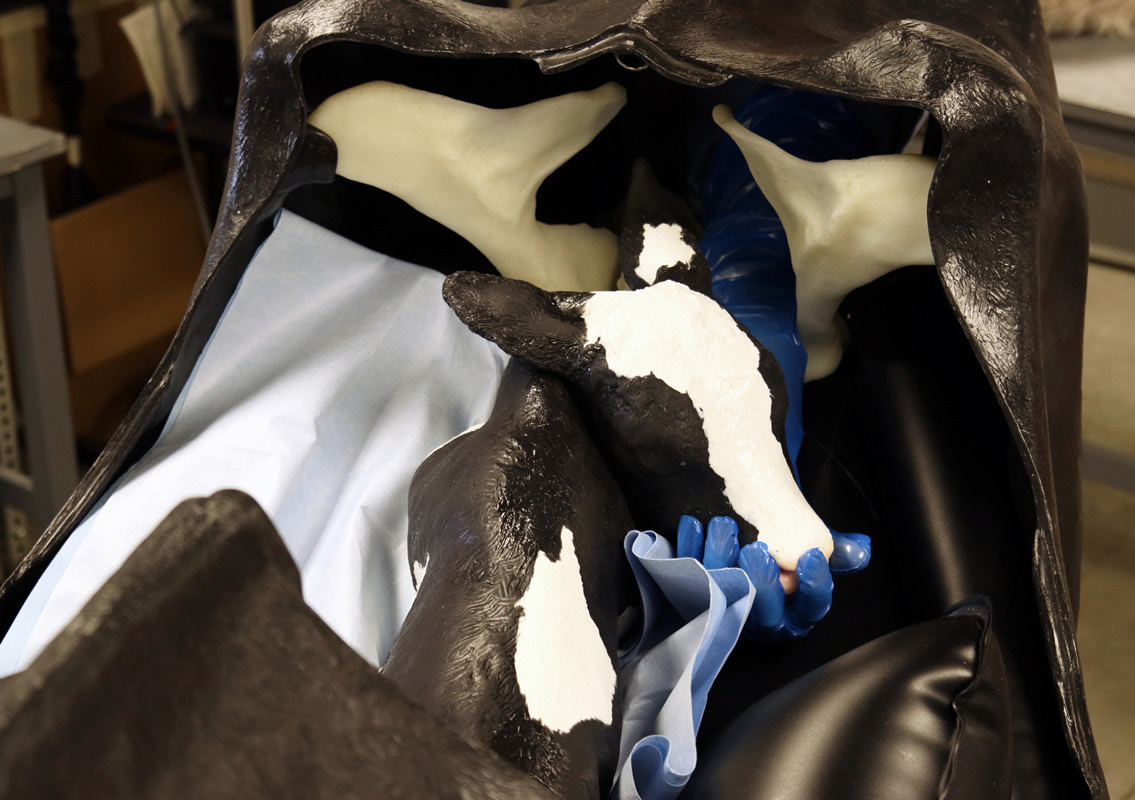
Figure 3. A demonstration of how to grasp the calf’s head to turn it towards the birth canal. (Dewell et al., Iowa State University Extension. Image: Andrew Kingsbury).
If the cow is straining, it may be difficult to push the calf back and turn the head. In this instance, a stainless steel OB chain can be used. Begin by placing a loop around the top of the calf’s head and then through the calf’s mouth, holding the standing end of the chain down by the calf’s mouth (Figure 4). Then, move the calf back by pushing on the calf’s chest and applying traction to pull the head toward you.
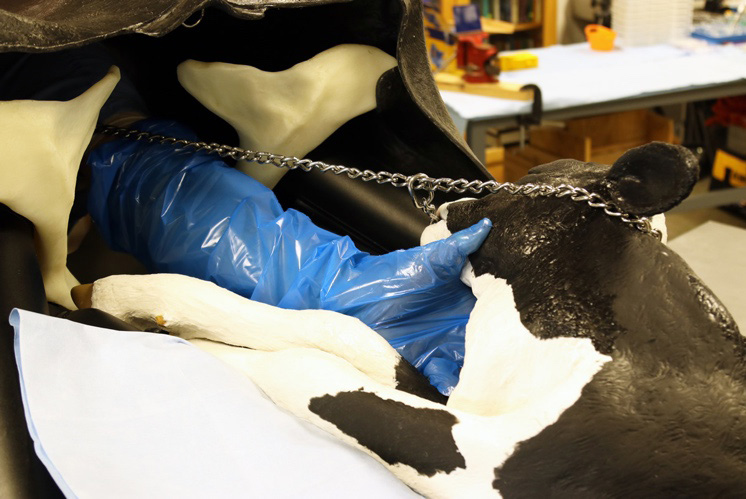
Figure 4. A demonstration of how to place a chain around the top of the calf’s head and then through the calf’s mouth. (Dewell et al., Iowa State University Extension. Image: Andrew Kingsbury).
HEAD BETWEEN FORELEGS
A calf with its head down and between its forelegs can often be corrected by following a similar method as when the head is retained by its side. A downward deviation of the head is when the calf’s head has fallen between its forelegs (Figure 5). To correct this abnormal posture, the calf will need to be pushed back into the uterus and have its head raised to rest on top of its forelegs. You can use techniques similar to the ones described for correcting a calf with its head turned to its side.
It is important to determine the viability of the calf before trying to correct this problem, as many calves that present with their head between their forelegs are already dead. If the calf is dead, contact a local veterinarian to see what steps to take next to protect the health of the cow.
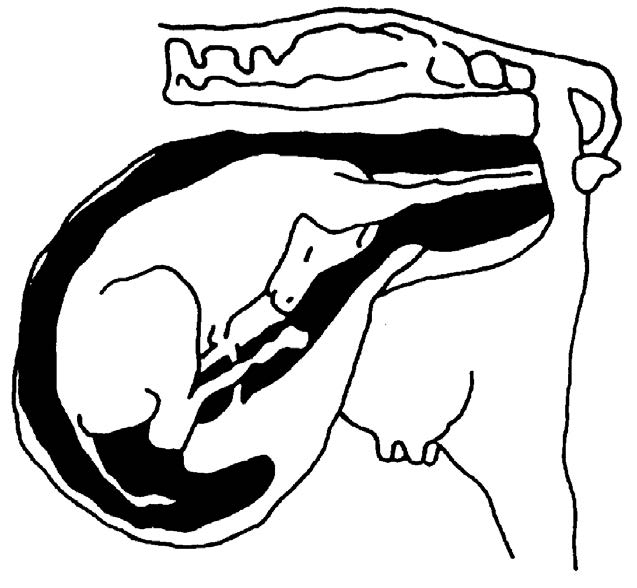
Figure 5. A malpresentation where the calf’s head is down between its forelegs. (Cooke et al., Image: Oregon State University Extension).
ONE OR BOTH FORELEGS RETAINED
Retention of one or both forelegs occurs when the calf’s head is presented, but one or both forelegs are retained (Figure 6). This abnormal presentation is normally easily corrected if the calf can still be pushed back into the uterus.
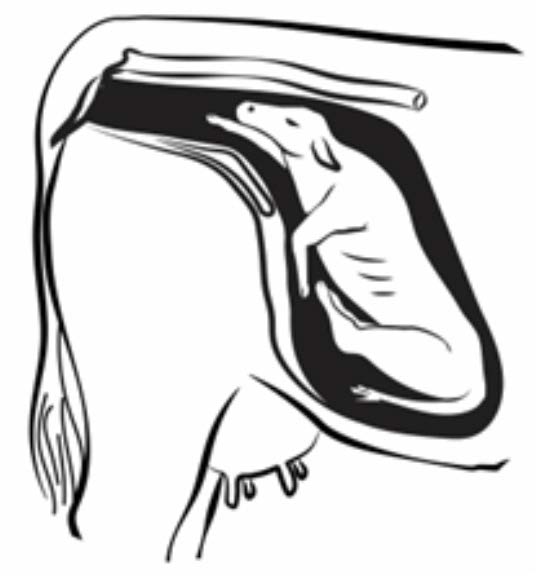
Figure 6. A malpresentation where one of the calf’s forelegs is retained. (Image: Beef Cattle Research Council).
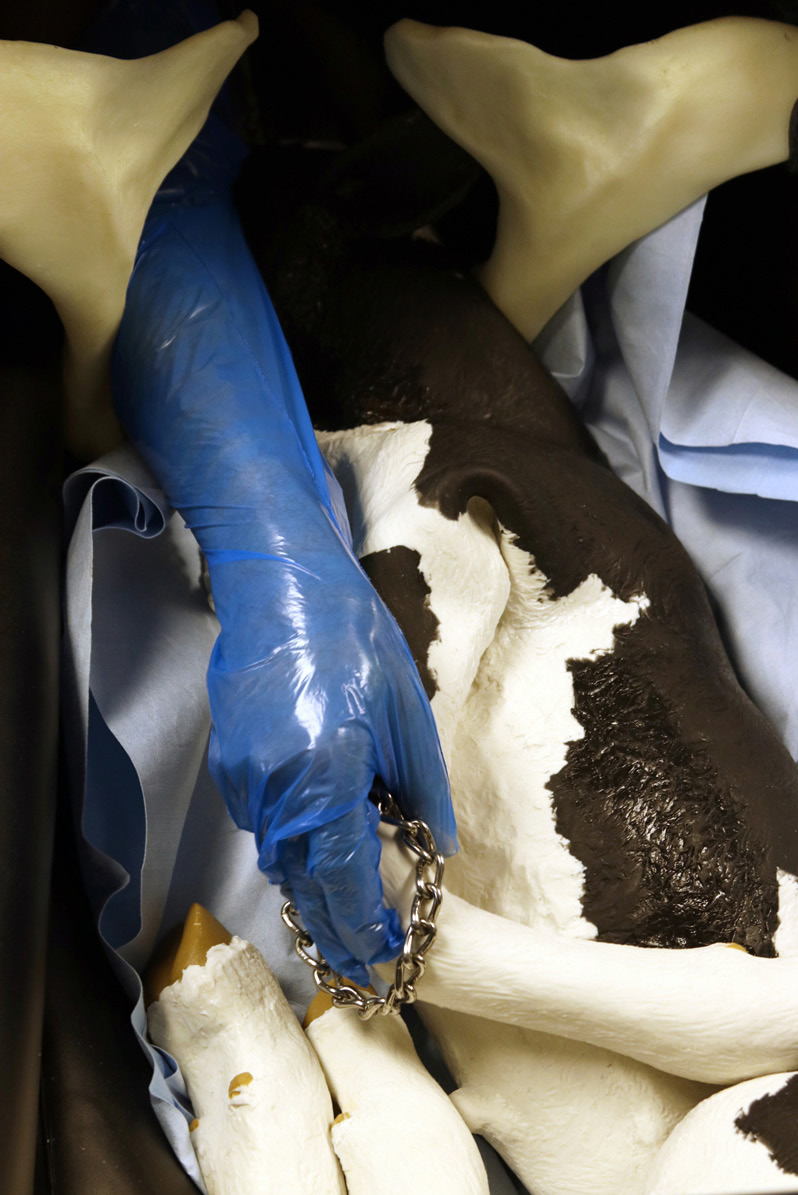
Figure 7. A demonstration of applying a chain to the retained foreleg to help move it into the birth canal. (Dewell et al., Iowa State University Extension. Image: Andrew Kingsbury).
After determining that the calf is viable, begin by putting a chain around the top of the calf’s head and through the calf’s mouth. If only one leg is retained, also loop a chain on the presented leg so that it remains forward and does not slip back into the uterus (Figure 7). Then, gently push the calf back into the uterus to give room to maneuver the fetus.
In many cases where one or both forelegs are retained, the calf’s knee will be just below the brim of the pelvis. Grasp the calf’s knee and bring it up toward the pelvic canal and then feel the way down to the calf’s foot. Be sure to cup the hooves with your hand so the hooves don’t tear the uterus as you move it. Then, lift the foot and carefully rotate the entire leg back. If the cow is straining or the uterus is too tight to push the calf back, try to push the calf’s knee back with one hand as you lift the hoof with your other hand.
If it is difficult to maneuver the leg or legs by hand, a chain can be applied to help move it into the birth canal. You may have to use one hand to help move the leg while pulling on the chain with the other.
BREECH
A breech presentation is an abnormal presentation in which the calf presents posteriorly and both hind limbs are retained (Figure 8). A long chain will be useful to help position the hind legs properly.
It may be necessary to push the calf back to maneuver the legs. Start by reaching along the calf’s side and grasping one of its hindlegs at the hock. Pull up so that the hock sits on the brim of the pelvis. Once the calf’s hock is in the pelvic canal, it will help keep the calf’s body pushed back.
Next, make a loose loop around the calf’s hock. Slide the loop down the calf’s leg until it slips over the fetlock. Then, tighten the loop, making sure the chain comes over the front of the leg and passes between the dewclaws (Figure 9). This will help curl the foot up when you pull on the chain so it is less likely to tear the uterus.
Use one hand to push the calf back into the uterus and rotate the leg. Do this by pushing forward on the calf while applying traction to the foot with the chain. Move slowly and gently so that the hoof does not tear the uterus. Once the first leg is positioned properly, the second leg can be positioned similarly. Once both legs are corrected, reposition the chains and pull the calf.

Figure 8. A breech position of a calf is butt first, with no front or hind limbs in the birth canal (Image: Beef Cattle Research Council).
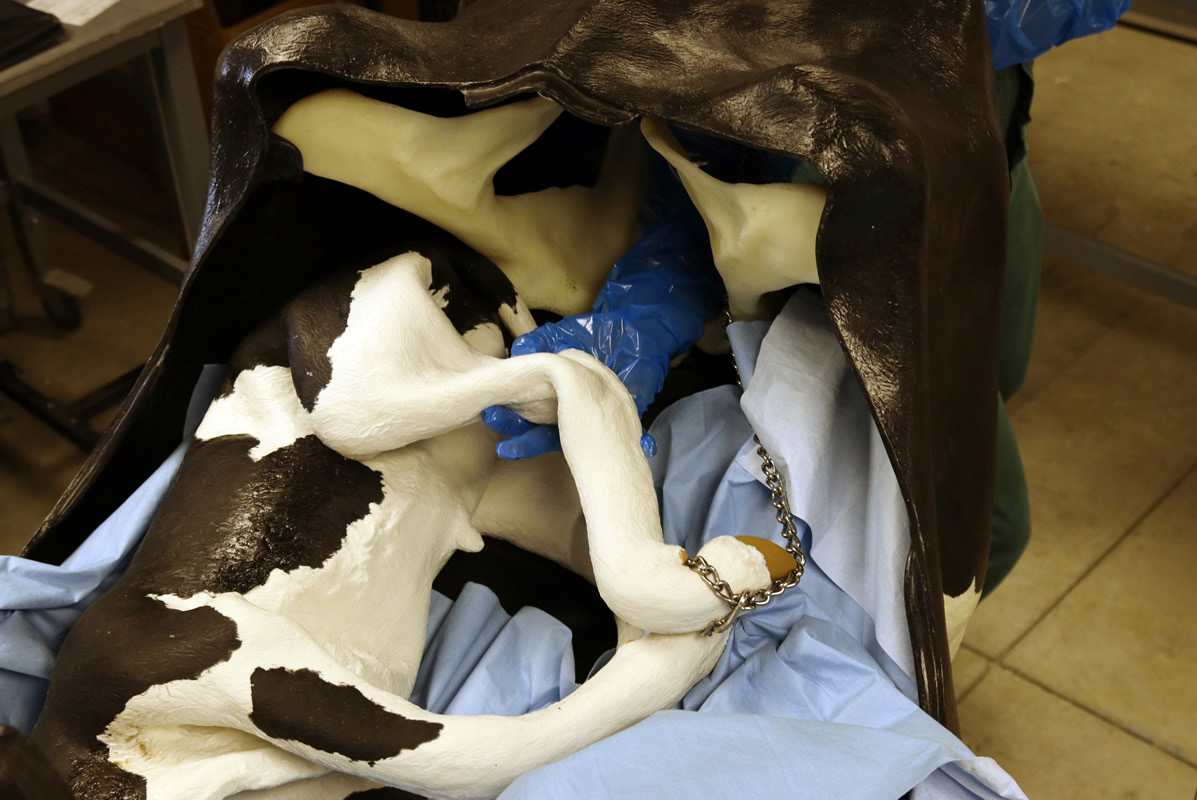
Figure 9. A demonstration of applying a chain to the calf’s leg. (Dewell et al., Iowa State University Extension. Image: Andrew Kingsbury).
TWINS
If twins enter the birth canal one at a time, there is typically no problem. However, twins occasionally try to enter the birth canal at the same time, which can cause a blockage.
In most of these cases, one calf can be pulled first, followed by the second. If one calf is closer to the birth canal, start with that twin. Feel along each leg to the body and then along the body to the opposite leg to ensure both legs belong to the same calf.
Prevention
Besides early and appropriate dystocia intervention, efforts to manage dystocia rates and mitigate its effects should begin long before calving season starts. With the most common cause of dystocia being maternal/fetal disproportion, careful selection processes focused on sire selection and replacement heifer development can help combat incidences of dystocia. However, it should be noted that an abnormal presentation of a calf is not predictable and there are not any direct methods to prevent an abnormal position. Occasionally, genetic defects can lead to malformations that may cause dystocia. Careful selection can also minimize genetic defects.
SIRE SELECTION
Most producers are aware of the impacts a sire can have on calving difficulty within their herd. Sires used for first-calf heifers are usually different than sires used for mature cows. Most breed associations publish expected progeny differences. Similarly, many seedstock operations utilize EPDs and it has become a technology to use to better understand the herd genetics. EPDs can be used to select a sire that has a decreased chance of causing dystocia. There are several traits producers should focus on when selecting sires to reduce calving problems.
Birth weight is a heritable trait that has historically been used to help reduce incidences of dystocia. However, growth traits are typically related, meaning that selecting for light birth weight also selects for lighter weaning and yearling weight, which may impact long-term profitability. Further, continual selection solely for low birth weight can have negative long-term effects. It can reduce the individual cow size and the pelvic diameter of the cow herd over time, subsequently impacting the chances of dystocia. With this in mind, producers need to find balance when selecting a sire, keeping in mind both birth weight and weaning/yearling weights.
Another useful EPD is calving ease direct. Calving ease direct shows the estimated percentage of unassisted births the bull will have when siring heifers. Calving ease direct accounts for birth weight (about a 60 percent influence) of the calf, as well as its shape. It is not negatively associated with the other growth traits. This means a bull with a high calving ease direct EPD does not necessarily have lower weaning and yearling weights. Collectively, EPDs are a valuable tool producers can use to lessen the incidence of dystocia within their herd; however, care needs to be given to consider how individual EPDs may affect later calf growth.
REPLACEMENT HEIFER DEVELOPMENT
Heifer development is important in reducing incidences of dystocia in a herd. Heifers are targeted to give birth for the first time at around 24 months of age. Most heifers will be at about 85 percent of their mature cow size at calving time. However, under-developed heifers may only be at about 70-80 percent of their mature size at calving, which increases the potential for dystocia.
A common misconception is that restricting the nutritional intake of a female can reduce dystocia by decreasing calf birth weight. Research has shown that although the calf may weigh less at birth, the risk of dystocia is increased due to a decreased pelvic size. This occurs because the growth of the heifer is restricted. Restricted nutrition during the final trimester of pregnancy is associated with weak labor, increased dystocia rate, decreased calf growth rate, prolonged postpartum anestrus, decreased subsequent pregnancy rate, and increased morbidity and mortality.
Maternal calving ease EPDs can be used to select for females that can improve calving ease in the herd. Additionally, using pelvic measurements before the breeding season or at the time of pregnancy can help to select heifers that have an acceptable size pelvis in comparison to the mature cow size of the herd. Heifers that have a small pelvic area before the breeding season can be selectively bred to easy-calving bulls, and those with a small pelvic area at the time of pregnancy examination can be identified for careful observation at calving.
References
Windeyer, Claire. 2024. Calving and Calf Management. Beef Cattle Research Council. www.beefresearch.ca/topics/calving-calf-management
Cooke, Reinaldo, Villarroel, Aurora, and Estill, Charles. 2018. Calving school handbook. Oregon State University Extension Service. extension.oregonstate.edu/onlineresource/calving-school-handbook
Dewell, Grant, Dewell, Renée, and Lippolis, Katy. N.D. Dystocia Prevention and Intervention. Iowa State University Extension. www.iowabeefcenter.org/calving/dystocia.html
Grussing, Taylor and Amundson, Olivia. 2023. Preventing Dystocia Before Calving Season Starts. South Dakota State University Extension. extension.sdstate.edu/preventingdystociacalving-season-starts
Lalman, David and Stein, Daniel. 2023. Body Condition Scoring of Cows. Oklahoma State University Extension.
extension.okstate.edu/fact-sheets/print-publications/afs/body-condition-scoring-of-cows-afs-3283-a.pdf
To download more free online MontGuides or order other publications, visit our online catalog at store.msuextension.org, contact your county or reservation MSU Extension office, or e-mail [email protected].
Copyright © 2025 MSU Extension
We encourage the use of this document for nonprofit educational purposes. This document
may be reprinted for nonprofit educational purposes if no endorsement of a commercial
product, service or company is stated or implied, and if appropriate credit is given
to the author and MSU Extension. To use these documents in electronic formats, permission
must be sought from the Extension Communications Director, 135 Culbertson Hall, Montana
State University, Bozeman, MT 59717; E-mail: [email protected]
The U.S. Department of Agriculture (USDA), Montana State University and Montana State University Extension prohibit discrimination in all of their programs and activities on the basis of race, color, national origin, gender, religion, age, disability, political beliefs, sexual orientation, and marital and family status. Issued in furtherance of cooperative extension work in agriculture and home economics, acts of May 8 and June 30, 1914, in cooperation with the U.S. Department of Agriculture, Cody Stone, Director of Extension, Montana State University, Bozeman, MT 59717.

